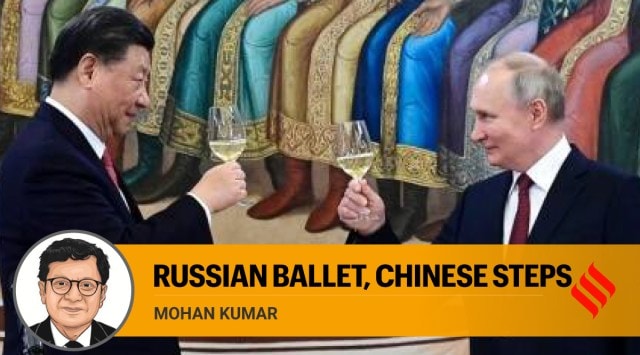Mohan Kumar

It is hard to overlook the strategic dimensions of the visit by Chinese President Xi Jinping to Moscow this week to meet Russian President Vladimir Putin. As is their wont when they meet, a fairly detailed joint statement was put out.
The main strategic takeaway is that Xi has not just doubled down on Russia but has specifically thrown his considerable weight behind the person of Putin. How else to explain the fact that even before Putin has announced his candidature for the Russian presidential elections due in March next year, Xi has backed Putin by expressing the hope that the latter would be re-elected as President of Russia. For Putin, who faces some internal dissent, this is a big deal: He is, after all, getting the endorsement of a big power for his policies in Ukraine. Xi’s personal endorsement of Putin is also a poke in the eye for the West and the International Criminal Court, which indicted him recently
The language of the joint statement on the war in Ukraine is what may be characterised as boilerplate. There is a predictable reference to the UN charter and to international law, but the reference to the “legitimate security concerns of all countries” and preventing the formation of “bloc confrontation” must have satisfied Russia enough to welcome Chinese attempts at mediation in the Ukraine imbroglio. Russia, therefore, called the Chinese peace proposals “constructive”. This, of course, means the Chinese peace proposals, such as they are, can be deemed dead on arrival by the Ukrainians and the West. We will have to see how the proposed telephone call between Xi and Ukrainian President Volodymyr Zelenskyy goes.
Much has been made by the commentariat about the lack of reference to the “no limits friendship” in the current joint statement, which figured in the much-vaunted February 4, 2022, Sino-Russian Joint Statement. But this would be a mistake. Basically, the two countries have reaffirmed their commitment to the June 2021 Treaty of Good-Neighbourliness, Friendship and Cooperation and to the February 4, 2022, joint statement as well. Curiously, the two countries characterise the nature of their bilateral ties as that of non-alignment, non-confrontation and non-targeting of third countries. It is hard to square this with Russia’s military actions in Ukraine, but the unstated argument here is that Russia was provoked into doing what it did in Ukraine.
There is an attempt to rationalise the UN General Assembly vote, which was overwhelmingly against Russia by arguing that if the vote was held today, the results may be different. Enough emphasis is paid to the democratisation of international relations and to the desire of both China and Russia to create a “multipolar world”.
The joint statement appears to suggest that China and Russia are joined at the hip when it affirms that Russia needs a prosperous and stable China and China in turn needs a strong and successful Russia. This runs directly counter to the US/NATO intention to either weaken and/or defeat Russia on the battlefield in Ukraine. The strongest evidence of the unfolding relationship came in the part of the joint statement, which asserted that China and Russia will extend support to each other on issues concerning their respective core interests. In China’s case, these core interests are well articulated: Taiwan, Hong Kong and Xinjiang. It must be assumed that there was a quid pro quo and that China too will support the core interests of Russia, which must perforce include Ukraine.
The joint statement places emphasis on strengthening trade and economic cooperation, stressing energy as a particular point of converging interest. The proposed China-Mongolia-Russia natural gas pipeline project gets pride of place, even as the West seeks to boycott Russian energy. Other areas of cooperation include civil aviation manufacturing, the automobile industry, shipbuilding and metallurgy. For obvious reasons, hardcore defence cooperation is conspicuous by its absence.
There are two possible interpretations of this omission. Either, this is an area China will not venture into, thereby creating inherent limits to the bilateral partnership. Alternatively, China will go ahead and do what it has to, on the sly. This will no doubt be closely monitored in the West.
The Xi-Putin summit and the consequent joint statement have two global, strategic implications: One for the West, and one for India. For the West, it should henceforth become clear that China will be loath to see Russia fail in Ukraine. After so much investment by China and Xi in Russia and Putin, it would be naïve to expect China to idly stand by and not take sides in the Ukraine conflict. This may well affect the future trajectory of the conflict in Ukraine. For India, this diminishes the strategic space available to it and complicates the security environment in ways previously not imagined. Furthermore, the reliability of Russia comes into play, especially if you stop to consider that Russia’s dependence on China may well grow exponentially. Last but not least, this could have the effect of India having to align itself more to the West, if only to protect its core interests vis-à-vis China.
What we are seeing, therefore, is a pincer movement in the international strategic landscape. On the one hand, China has decided to throw its entire weight behind Russia and create an alliance of sorts. On the other hand, the US and Europe will henceforth need all the support they can muster from their allies and partners to counter the above.
No comments:
Post a Comment